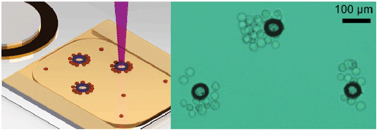Optoacoustic tweezers: a programmable, localized cell concentrator based on opto-thermally generated, acoustically activated, surface bubbles†
Abstract
We present a programmable, biocompatible technique for dynamically concentrating and

* Corresponding authors
a Department of Chemical Engineering, The Pennsylvania State University, University Park, PA 16802, USA
b
Department of Engineering Science and Mechanics, The Pennsylvania State University, University Park, PA 16802, USA
E-mail:
junhuang@psu.edu
Fax: +1 814-865-9974
Tel: +1 814-863-4209
We present a programmable, biocompatible technique for dynamically concentrating and

 Please wait while we load your content...
Something went wrong. Try again?
Please wait while we load your content...
Something went wrong. Try again?
Y. Xie, C. Zhao, Y. Zhao, S. Li, J. Rufo, S. Yang, F. Guo and T. J. Huang, Lab Chip, 2013, 13, 1772 DOI: 10.1039/C3LC00043E
To request permission to reproduce material from this article, please go to the Copyright Clearance Center request page.
If you are an author contributing to an RSC publication, you do not need to request permission provided correct acknowledgement is given.
If you are the author of this article, you do not need to request permission to reproduce figures and diagrams provided correct acknowledgement is given. If you want to reproduce the whole article in a third-party publication (excluding your thesis/dissertation for which permission is not required) please go to the Copyright Clearance Center request page.
Read more about how to correctly acknowledge RSC content.
 Fetching data from CrossRef.
Fetching data from CrossRef.
This may take some time to load.
Loading related content
